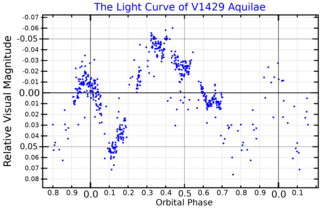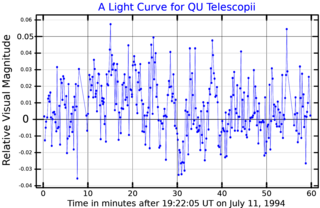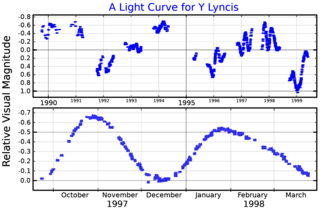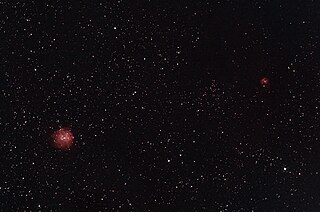
RV Tauri variables are luminous variable stars that have distinctive light variations with alternating deep and shallow minima.

NO Aurigae is a pulsating variable star in the constellation Auriga. It is an unusually-luminous asymptotic giant branch star about 3,500 light years away.

QS Virginis is an eclipsing binary system approximately 163 light-years away from the Sun, forming a cataclysmic variable. The system comprises an eclipsing white dwarf and red dwarf that orbit each other every 3.37 hours.
HD 27274, also known as Gliese 167, is a solitary, orange hued star located in the southern constellation Dorado. It has an apparent magnitude of 7.63, making it readily visible in binoculars, but not to the naked eye. Based on parallax measurements from the Gaia spacecraft, the star is known to be located 42.5 light-years away from the Solar System However, it is drifting closer with a heliocentric radial velocity of −23 km/s. At its current distance, HD 27274 is dimmed down by 0.05 magnitudes due to interstellar dust.

V1429 Aquilae is a candidate luminous blue variable multiple star system located in the constellation of Aquila. It is often referred to by its Mount Wilson Observatory catalog number as MWC 314. It is a hot luminous star with strong emission lines in its spectrum.

IRAS 19475+3119 is a protoplanetary nebula in the constellation of Cygnus, 15,000 light-years away. The central star, V2513 Cygni, is an F-type post-AGB star.

EC 20058-5234 , is a star in the constellation Telescopium. With an apparent magnitude of 15.03, it's impossible to detect with the naked eye and requires a powerful telescope to be seen; this degenerate object is located 388 light years from the Solar System based on parallax.
IRC −10414 is a red supergiant and runaway star in the constellation Scutum, a rare case of a red supergiant with a bow shock.

S Apodis, also known as HD 133444 is a variable star located in the southern circumpolar constellation Apus. It has an apparent magnitude ranging from 9.6 to 17, which is below the limit for naked eye visibility. The object is located relatively far at a distance of approximately 15,000 light years based on Gaia DR3 parallax measurements, but it is drifting closer with a heliocentric radial velocity of −75 km/s.

EV Carinae is a red supergiant and pulsating variable star of spectral type M4Ia in the constellation Carina. It is a semiregular variable star with its apparent magnitude varying between 7.4 and 9.0 in the visible band, making it only seen by binoculars or a telescope. Various periods have been identified, but the dominant one is around 347 days. It is an MK spectral standard star for the class M4.5Ia.

Y Lyncis is a semiregular variable star in the constellation Lynx. It is an asymptotic giant branch star of spectral type M6S, with a luminosity class of Ib, indicating a supergiant luminosity. It is around 1,160 light years away.
WR 111 is a Wolf-Rayet (WR) star in the constellation Sagittarius. It is magnitude 7.8 and lies about 5,150 light-years away. It is one of the brightest and most closely studied WR stars.

HV 888, also known as WOH S140, is a red supergiant (RSG) star located in the Large Magellanic Cloud. It is possibly among the largest known stars, with reliable estimates of its radius ranging from 1,353 R☉ to 1,584 R☉, and is also one of the most luminous of its type with a range of nearly 300,000 to over 500,000 times that of the Sun (L☉). The effective temperature is estimated to be around 3,500 K. If placed at the center of the Solar System, its photosphere would engulf the orbit of Jupiter.

WR 120 is a binary containing two Wolf-Rayet stars in the constellation of Scutum, around 10,000 light years away. The primary is a hydrogen-free weak-lined WN7 star, the secondary is a hydrogen-free WN3 or 4 star, and the system is a possible member of the cluster Dolidze 33. From our point of view, WR 120 is reddened by 4.82 magnitudes, and it has the variable designation of V462 Scuti.

HD 326823, also known as V1104 Scorpii, is a binary star containing a unique emission-line star, which is in the midst of transitioning to a nitrogen-rich Wolf-Rayet star, as well as being a candidate Luminous blue variable, located 4,142 light years away in the constellation of Scorpius. The primary is very evolved, because it is composed of almost entirely helium, and only 3% of it is still hydrogen, and it has lost most of its mass to the now-very-massive secondary. The underlying mechanisms and mass transfers in the system are comparable to other W Serpentis systems, such as Beta Lyrae and RY Scuti.

NGC 1624-2 is a massive O-type star located in the star cluster NGC 1624, in the constellation of Perseus, about 16,800 light years away. NGC 1624-2 is notable for being most strongly magnetised O-type star known, with a magnetic field strength of 20 kG, or about 20,000 times the Sun's magnetic field strength. It hosts a large and dense magnetosphere, formed from the interaction between its very strong magnetic field and its dense, radiatively-driven stellar wind, which also absorbs up to 95% of x-rays generated from around the star.

AF Columbae, also known as HD 42682, is a solitary, red hued variable star located in the southern constellation Columba, the dove. It has an apparent magnitude that fluctuates between 5.6 and 5.71. Nevertheless, it is faintly visible to the naked eye. Parallax measurements from the Gaia spacecraft place the star relatively far at a distance of 820 light years. However, it is approaching the Solar System with a poorly constrained radial velocity of −19 km/s.
HD 34255, also known HR 1720, is a star located in the northern circumpolar constellation Camelopardalis, the giraffe. It has an apparent magnitude of 5.60, allowing it to be faintly visible to the naked eye. The object is located relatively far at a distance of about 1.65 kly but is approaching the Solar System with a heliocentric radial velocity of −7.7 km/s.
WR 119 is a Wolf–Rayet star located about 10,500 light years away in the constellation Scutum. WR 119 is classified as a WC9 star, belonging to the late-type carbon sequence of Wolf-Rayet stars. WR 119 is noteworthy for being the least luminous known Wolf-Rayet star, at just over 50,000 L☉. The most recent estimate is even lower, at just 42,700 L☉, based on the most recent analysis using Gaia DR2 data.

HD 22764, also known as HR 1112, is an orange hued star located in the northern circumpolar constellation Camelopardalis. It has an apparent magnitude of 5.78, allowing it to be faintly visible to the naked eye. The object is located relatively far at a distance of approximately 1,770 light years based on Gaia DR3 parallax measurements but is approaching the Solar System with a heliocentric radial velocity of −12.5 km/s. At its current distance, HD 22764's brightness is diminished by 0.66 magnitudes due to interstellar dust.















